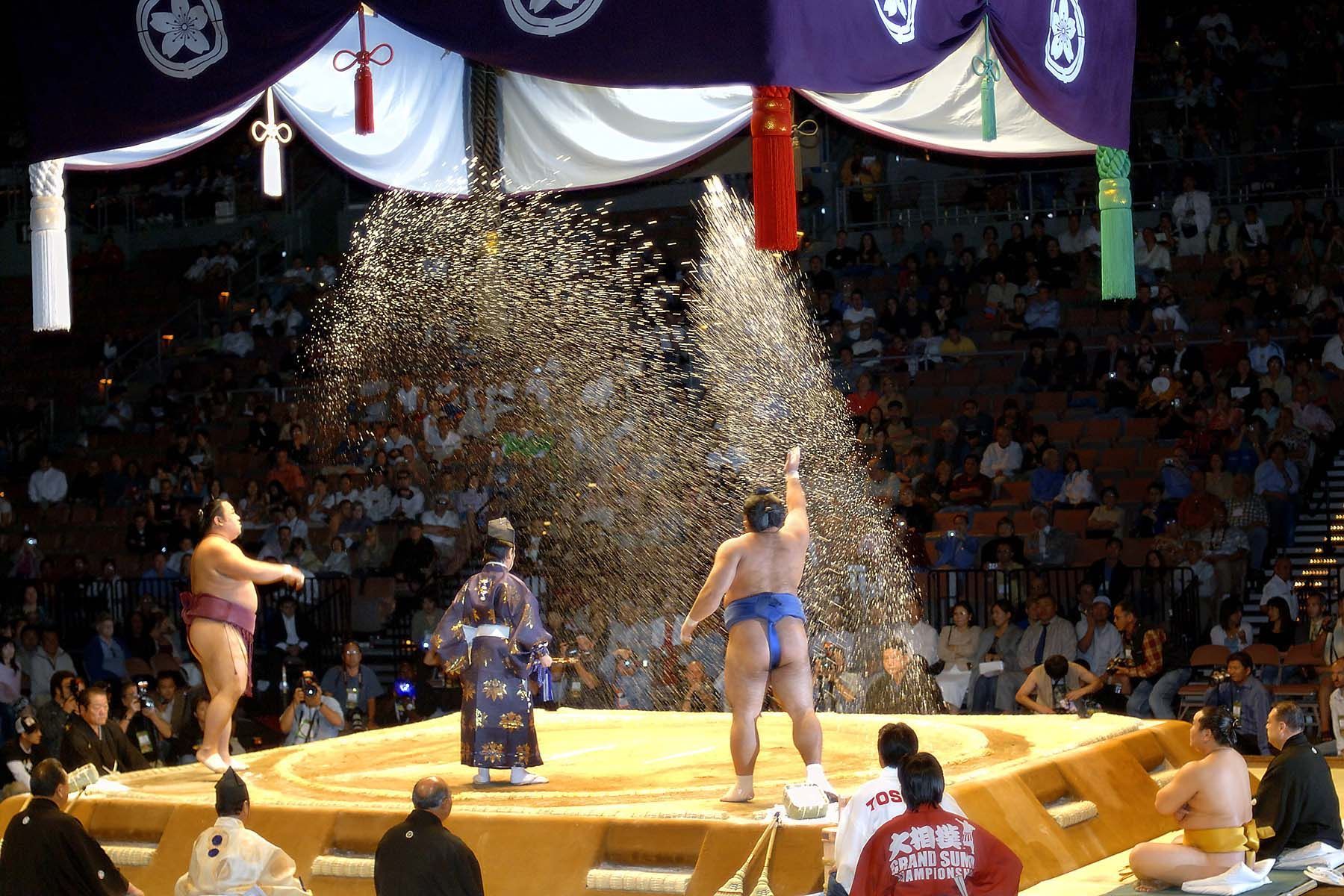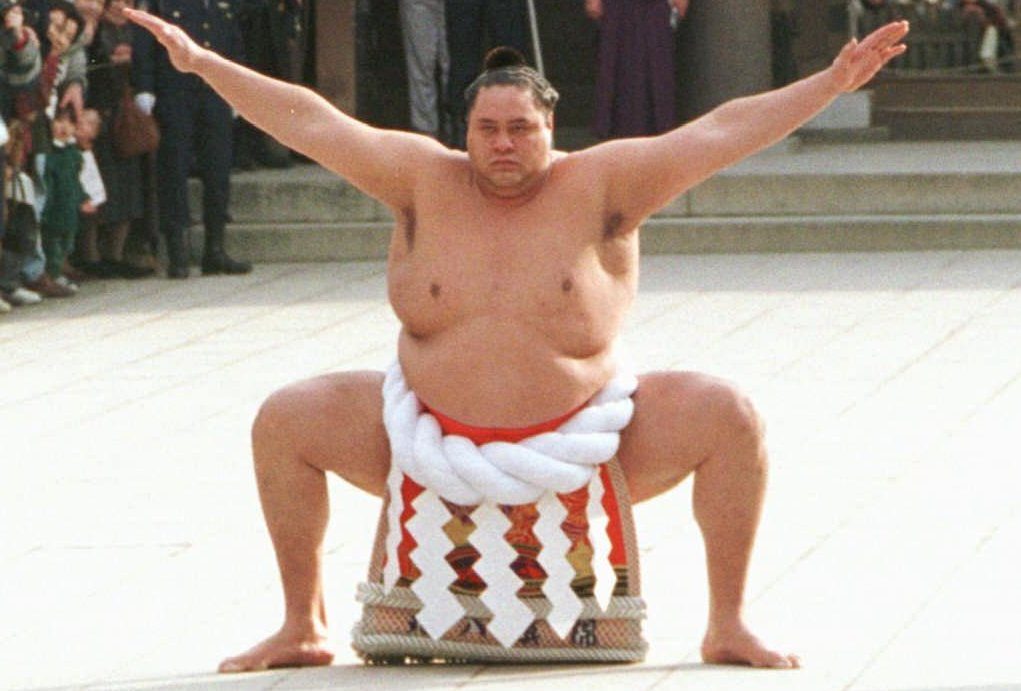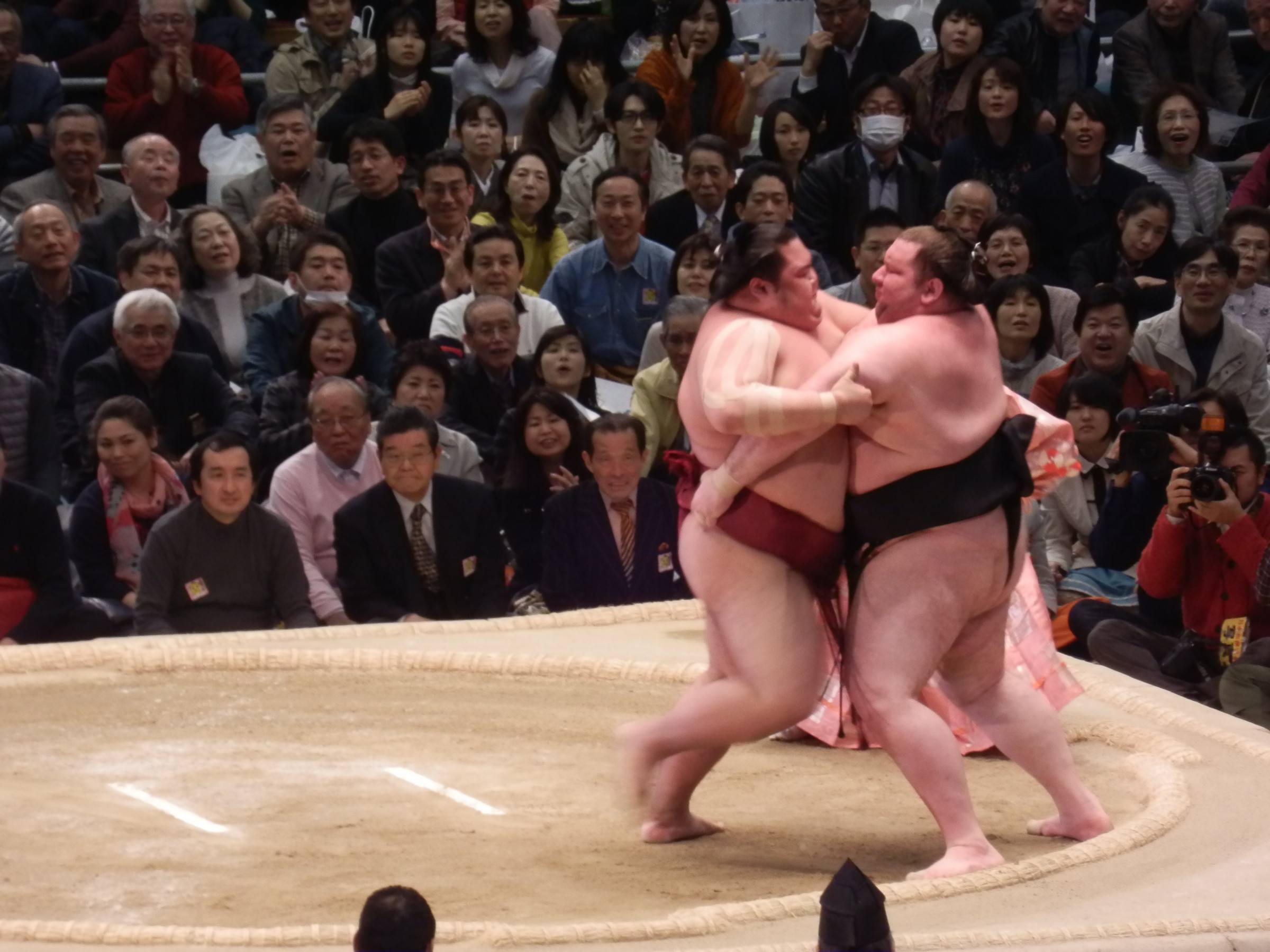Like this post? Help us by sharing it!
Everyone thinks they know what sumo wrestling is. A sand covered ring. Loin cloths. Men slamming into each other.
But there’s a lot more to Japan’s national sport than that…
1. Sumo is a religious ritual
Compared with most sports in the world today, sumo originated a long time ago – a really long time ago – about 1,500 years. From the very beginning it was entwined with Shinto ritual, performed at shrines to ensure a bountiful harvest and to honour the spirits – known as kami.

Shinto principles continue to govern the everyday life of sumo wrestlers today. Each of the ring-entering ceremonies is a Shinto purification ritual, and every newly promoted yokozuna (the highest rank in sumo) performs his first ring-entering ceremony at the Meiji Shrine in Tokyo. The canopy that hangs over the ring is modelled after the roof of a Shinto shrine, indicating that the ring itself is a holy place.

2. Hands down: the rules of the match
A sumo match doesn’t start until both wrestlers have placed both hands on the ground at the same time. Each wrestler tries to psyche the other out, pretending to put his hand down and then getting back up again.
Once they finally do begin, it’s very rare for sumo bouts to last longer than a few seconds – although occasionally they can last up to four minutes. The action is very fast-paced and exciting. A match ends when one of the wrestlers is either thrown out of the ring, or if any part of his body apart from the soles of his feet touches the ground.
Interestingly, the match can also end if one of the wrestlers loses his mawashi, or loincloth – in which case the de-loinclothed wrestler is disqualified. More interestingly still, this rule was only adopted after Japan began to take on European (read: prudish) attitudes toward nudity.
This outcome is very rare in sumo, but a wardrobe malfunction did occur during a match in May 2000, when the unfortunate wrestler Asanokiri exposed himself and was disqualified immediately.
3. Hazing and hierarchy: Sumo life is hard
It would be easy to assume that wrestlers live a life of excess outside their training schedule. In reality, sumo wrestlers’ lives are possibly the most rigidly regimented and disciplined of any athletes in the world.
The sumo beya, or ‘stable’, is where the wrestlers live, eat, train and sleep throughout their career – unless they get married, in which case they are allowed to live in an independent dwelling. An average stable will contain around 15 wrestlers, and is arranged according to a strict hierarchy.

Life is hardest for the lower ranked wrestlers, who are expected to get up earliest and to cook, clean, serve food, and generally wait on the higher ranked wrestlers. They even have to bathe last after training, and get last pick at dinner time – after their more senior peers have wolfed down the best bits.
If this sounds hard, it gets even harder. It is a fact of sumo life that the younger, inexperienced wrestlers endure systematic hazing and physical punishment in order to toughen them up. This is part and parcel of sumo culture and something that young wrestlers know to expect. However, sometimes it can go too far, resulting in injury – and in some very rare cases, even death.
To learn even more about life in a sumo beya, we can arrange for you to visit one – with exclusive access to a morning training session.
4. Bigger hasn’t always meant better
Since there are no weight divisions in professional sumo, every wrestler basically just wants to get as big as humanly possible so that he can use his weight in the ring. But it wasn’t until well into the twentieth century that this modern image of sumo wrestlers emerged – with earlier wrestlers typically much more wiry and muscular.
A famous exception to the “bigger the better” rule is Takanoyama Shuntaro, known as the “Skinny Sumo”: a Czech wrestler distinctive for his diminutive size. Despite being comparatively minuscule, Takanoyama has had impressive success in the rankings, reaching the makuuchi division in 2011.

If you’ve ever wondered just how modern sumo wrestlers bulk up, it’s all thanks to something called chanko nabe. It’s a special kind of (delicious) hotpot packed with meat, veggies and noodles that is specifically associated with sumo wrestlers in Japan. This alone doesn’t do the trick – wrestlers have a special routine of exercising on an empty stomach and sleeping after eating to help store their calories (purportedly up to 10,000 per day).
Unfortunately this increase in weight, combined with a high consumption of alcohol, means that modern sumo wrestlers’ life expectancy is more than ten years shorter than that of the average Japanese male.
5. Sumo wrestlers aren’t allowed to drive cars
It sounds absurd, but this is actually true. After a serious car accident involving a sumo wrestler, the Sumo Association banned wrestlers from driving their own cars.
6. The last night of a sumo tournament is called the ‘pleasure of a thousand autumns’
This rather poetic epithet echoes the words of 14-15th century playwright Zeami Motokiyo, and is meant to convey the excitement of the decisive bouts and the celebration of the victor – who receives all kinds of elaborate prizes for his success (including a giant Hello Kitty and soy sauce bottle at the 2025 Grand Sumo Tournament in London). And a fat wad of cash, of course.
7. Sumo referees carry a sword
Sumo referees, or gyoji, are as interesting as the wrestlers. Like the wrestlers, they enter the world of sumo at a young age (about sixteen) and remain in their profession until they retire. The traditional clothing they wear in the ring is strictly graded according to rank, and as they progress up the ranks they earn honorific names by which they become known. The top ranked gyoji (the equivalent of yokozuna for wrestlers) takes the name Kimura Shonosuke. Unlike the rank of yokozuna, the gyoji rank can only be held by one person at any one time.

Perhaps most interestingly, the gyoji also carries a sword, or tanto, which is about six to twelve inches in length. The significance of the sword is to show that the gyoji understands the seriousness of the decisions he has to make – and is prepared to commit seppuku (ritual suicide by disembowelment) if he makes a bad decision. Talk about pressure.
Thankfully, today the gyoji usually just submits his resignation papers instead as a gesture of contrition. In most cases the gesture is just that; the erring gyoji’s resignation is very rarely accepted.
8. Sumo wrestlers have to wear traditional clothes
In accordance with the strict rules governing their lives, sumo wrestlers aren’t allowed to choose their own clothes. As soon as they join a stable they are expected to grow their hair in order to form a topknot, or chonmage, similar to the samurai hairstyles of the Edo Period. They are expected to wear this hairstyle and traditional dress at all times when out in public – which means that sumo wrestlers are pretty easy to spot on the subway…
Not only must they wear traditional dress, but the specifics of that dress is also closely controlled. The less experienced wrestlers must wear thin, lower-quality yukata (a cotton robe) and geta (wooden sandals) even in winter, Meanwhile, higher ranked wrestlers can wear increasingly swanky robes – and even get to choose their own!
9. They’re not allowed to behave how they like
In addition to the strict routine governing their training schedule, sumo wrestlers are expected to control their demeanour and personality in public. Rules delineate that when out and about, wrestlers must be self-effacing and softly spoken, and during tournaments they should refrain from showing joy at winning or disappointment at losing. No amateur dramatics or self-congratulatory gloating here.
10. It’s a strictly Japanese sport
Sumo stables were once allowed to recruit as many foreign wrestlers as they liked. Then, after one stable recruited six Mongolians at once, there was a mass gaijin (‘foreigner’) induced panic – and today stables are only allowed to have one foreign wrestler (defined as somebody born outside Japan) at any one time.
These foreign wrestlers are expected to speak Japanese, and must be well-versed in Japanese culture – meaning that foreign sumo wrestlers face all the same challenges that Japanese ones do, but with the added anxiety of having to learn to live and breathe like a Japanese person.

11. Women can’t be sumo wrestlers
Women are actually forbidden from participating. The Sumo Association doesn’t even allow women to enter the sumo ring, as it is considered a violation of the purity of the ring.
This caused a bit of an issue when there was a female Governor of Osaka – Fusae Ohta, governor from 2000-2008. The Governor traditionally presents the Governor’s Prize in the ring at the end of the tournament, but obviously this is a bit tricky when the Governor is banned from the ring. Ohta wasn’t all too impressed by this ruling, and she repeatedly challenged the Sumo Association to allow her to fulfill her traditional role as Governor. She was repeatedly turned down.
It wasn’t always the case that sumo was so hostile to women, however, and as early as the 18th century there was a form of female sumo commonly performed in some areas of Japan. Most of the time this was just a form of entertainment, but in some areas of Japan female sumo wrestlers did have a serious role in Shinto rituals. Today it is prohibited from taking place in anything but an amateur setting.

See the sumo for yourself
It’s difficult to get tickets to see sumo tournaments from outside Japan – but if you want to see the action for yourself, we can arrange your tickets for you.
Just mention it when you start planning your Japan holiday with us. Get in touch today.






